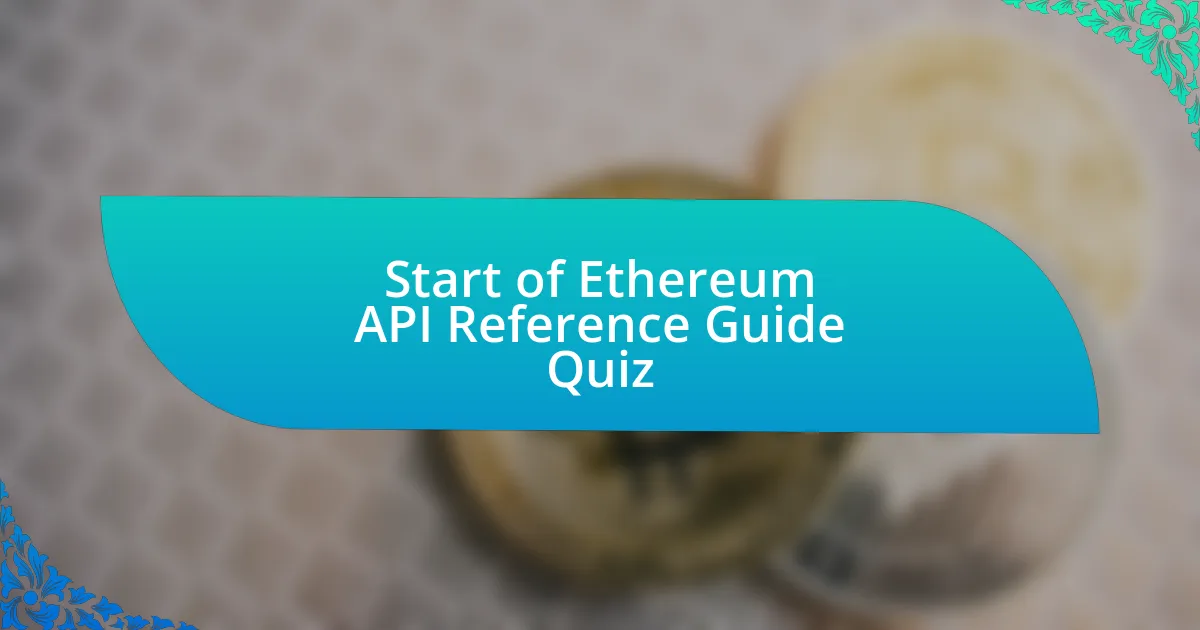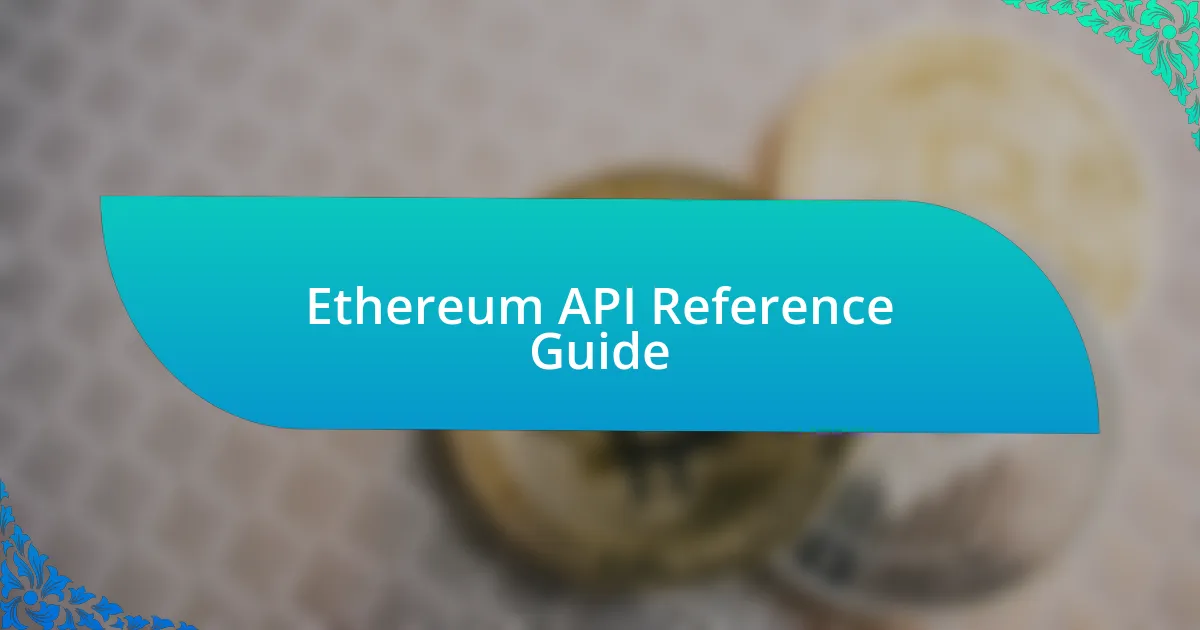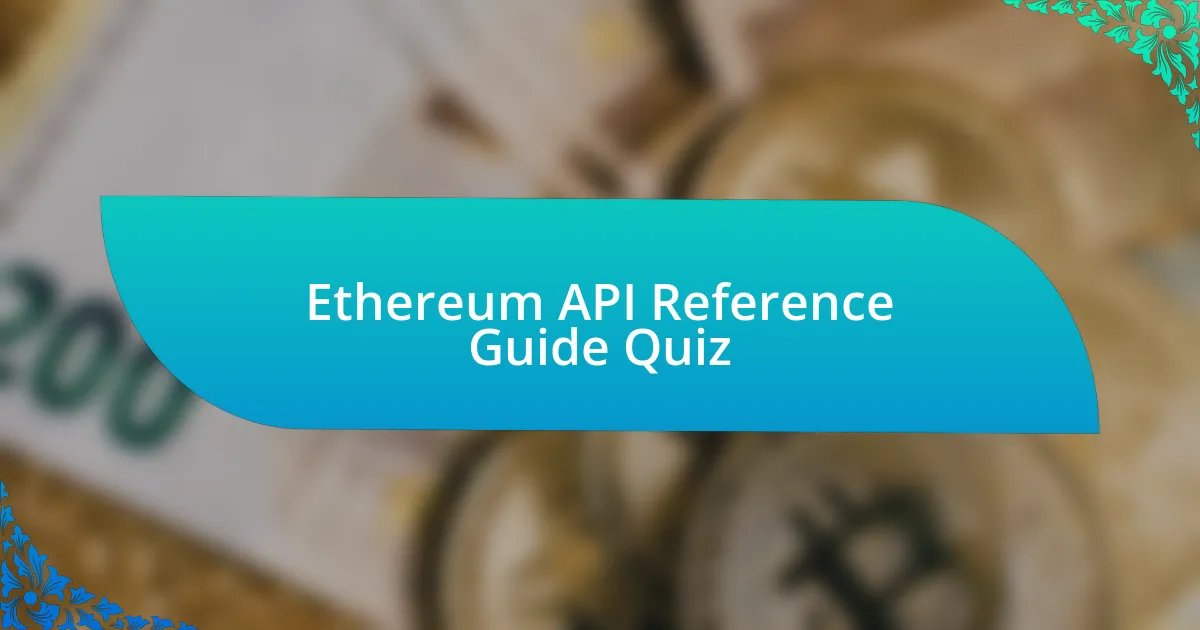
Start of Ethereum API Reference Guide Quiz
1. What is the primary purpose of the Ethereum JSON-RPC API?
- To create smart contracts on the Ethereum blockchain.
- To interact with the Ethereum blockchain by reading blockchain data or sending transactions to the network.
- To visualize Ethereum blockchain transactions in a user interface.
- To mine new blocks on the Ethereum blockchain.
2. What is JSON-RPC in the context of Ethereum?
- A standard for smart contract deployment.
- A binary format for data exchange.
- A stateless protocol for remote procedure calls.
- A protocol for encrypted communication.
3. How does an application connect to an Ethereum node?
- By directly connecting to the Ethereum network via TCP.
- By using REST APIs developed by third parties.
- By using the JSON-RPC specification implemented by every Ethereum client.
- By establishing a WebSocket connection to mining pools.
4. What are the transport methods supported by JSON-RPC?
- FTP transfers using a server-client model.
- SSH tunnels within secure networks.
- Bluetooth connections for peer-to-peer sharing.
- HTTP, sockets, or in various message passing environments.
5. What data format does JSON-RPC use?
- JSON
- XML
- CSV
- YAML
6. What are the default block parameters in JSON-RPC?
- HEX String (an integer block number)
- String `current` (for the current state block)
- String `oldest` (for the oldest block)
- String `newest` (for the latest block)
7. How can you fetch historical records of every block back to genesis using JSON-RPC?
- Accessing historical records through the Ethereum website.
- Fetching data using a simple HTTP GET request.
- Using methods like eth_getBlockTransactionCountByHash, eth_getBlockByNumber, and eth_getTransactionByHash.
- Retrieving blocks by manually parsing the blockchain data files.
8. What is the purpose of the eth_protocolVersion method in JSON-RPC?
- To verify the integrity of transactions.
- To send transactions to the network.
- To return the current Ethereum protocol version.
- To query historical blocks by number.
9. How do you make a request to the eth_protocolVersion method using curl?
- curl -X DELETE –data `{`jsonrpc`:`2.0`,`method`:`eth_protocolVersion`}`
- curl -X GET –data `{`method`:`eth_protocolVersion`}`
- curl -X PUT –data `{`jsonrpc`:`2.0`,`method`:`eth_protocolVersion`}`
- Using curl -X POST –data `{`jsonrpc`:`2.0`,`method`:`eth_protocolVersion`,`params`:[],`id`:67}`
10. What is the result of the eth_protocolVersion method?
- A boolean indicating if the Ethereum protocol is running.
- An integer representing the current Ethereum protocol version.
- A complex object containing Ethereum network stats.
- A string representing the current Ethereum protocol version.
11. What are some examples of JSON-RPC API endpoints?
- eth_fetchLatestState
- eth_getBlockByNumber
- eth_getTransactionStatus
- eth_getNodeStatus
12. How can you use the JSON-RPC API Playground to discover and try out API methods?
- By creating a local server to run the JSON-RPC API.
- By sending requests to the server via email for method testing.
- By building a complex frontend framework without using the playground.
- By using the playground tool to explore and test the available methods and networks supported by various node providers.
13. What is the purpose of the defaultBlock parameter in JSON-RPC requests?
- To define the type of transaction being submitted to the network.
- To determine the height of the block when requests are made that act on the state of Ethereum.
- To specify the amount of gas required for a transaction.
- To set the timeout duration for JSON-RPC requests.
14. What are the possible values for the defaultBlock parameter?
- String `current` (for the current block)
- HEX String (an integer block number)
- Integer (a whole number)
- String `recent` (for the most recent block)
15. How can you fetch a block by its hash using JSON-RPC?
- Using the eth_getBlockTransactionCountByNumber method.
- Using the eth_getTransactionReceipt method.
- Using the eth_getBlockByHash method.
- Using the eth_getTransactionByHash method.
16. How can you fetch a block by its number using JSON-RPC?
- Using the eth_fetchBlockByNumber method.
- Using the eth_getBlockMethodByNumber method.
- Using the eth_getBlockByNumber method.
- Using the eth_blockByNumber method.
17. What is the purpose of the eth_getTransactionByHash method in JSON-RPC?
- To delete a transaction from the blockchain.
- To create a new transaction in the network.
- To validate a transaction`s signature.
- To fetch a transaction by its hash.
18. What is the purpose of the eth_getTransactionByBlockHashAndIndex method in JSON-RPC?
- To update the Ethereum protocol version.
- To retrieve the balance of an Ethereum account.
- To send a transaction to the Ethereum network.
- To fetch a transaction by its block hash and index.
19. What is the purpose of the eth_getTransactionByBlockNumberAndIndex method in JSON-RPC?
- To fetch a block by its number and timestamp.
- To send a transaction to the network by its block index.
- To fetch a transaction by its block number and index.
- To retrieve the status of a transaction by its block hash.
20. How can you fetch a transaction receipt using JSON-RPC?
- Using the eth_getTransactionReceipt method.
- Using the eth_getBlockByNumber method.
- Using the eth_getTransactionByHash method.
- Using the eth_getBlockByHash method.
21. What is the purpose of the eth_getUncleByBlockHashAndIndex method in JSON-RPC?
- To get the latest block`s details.
- To send a transaction to the network.
- To retrieve user account balances.
- To fetch an uncle block by its block hash and index.
22. What is the purpose of the eth_getUncleByBlockNumberAndIndex method in JSON-RPC?
- To fetch a block by its number and index.
- To fetch a receipt by its block hash and index.
- To fetch a transaction by its block number and index.
- To fetch an uncle block by its block number and index.
23. How can you query the current Ethereum protocol version using JSON-RPC?
- Using the eth_protocolVersion method.
- Using the eth_getVersion method.
- Using the eth_currentVersion method.
- Using the eth_getProtocolVersion method.
24. What is the return value of the eth_protocolVersion method?
- A number indicating the block height.
- A boolean value for network status.
- An object containing transaction details.
- A string representing the current Ethereum protocol version.
25. How do you use curl to make a request to the eth_protocolVersion method?
- curl -X POST –data `{`jsonrpc`:`2.0`,`method`:`eth_protocolVersion`,`id`:67}`
- curl -X POST –data `{`method`:`eth_protocolVersion`,`params`:[],`id`:67}`
- curl -X POST –data `{`jsonrpc`:`2.0`,`method`:`eth_protocolVersion`,`params`:[],`id`:67}`
- curl -X GET –data `{`jsonrpc`:`2.0`,`method`:`eth_protocolVersion`,`params`:[],`id`:67}`
26. What are some historical methods available in JSON-RPC?
- Methods include eth_blockNumber, eth_gasPrice, eth_getLogs, eth_getAccounts.
- Methods include eth_protocolVersion, eth_sendTransaction, eth_call, eth_chainId.
- Methods include eth_getBlockByHash, eth_getBlockByNumber, eth_getTransactionByHash, eth_getTransactionReceipt.
- Methods include eth_getBlockTransactionCountByHash, eth_getBlockTransactionCountByNumber, eth_getUncleCountByBlockHash, eth_getUncleCountByBlockNumber, eth_getBlockByHash, eth_getBlockByNumber, eth_getTransactionByHash, eth_getTransactionByBlockHashAndIndex, eth_getTransactionByBlockNumberAndIndex, eth_getTransactionReceipt, eth_getUncleByBlockHashAndIndex, and eth_getUncleByBlockNumberAndIndex.
27. How can you use the JSON-RPC API Playground to discover supported methods and networks?
- By reading the Ethereum whitepaper to learn about its features and components.
- By using the playground tool to explore and test the available methods and networks supported by various node providers.
- By analyzing raw network packets to decode API requests and responses.
- By submitting JavaScript code snippets that automatically generate API calls.
28. What is the purpose of the defaultBlock parameter in historical methods?
- To specify the type of transaction to be processed in the request.
- To determine the height of the block when requests are made that act on the state of Ethereum.
- To limit the number of transactions that can be returned in a single request.
- To enforce security standards for all requests made to the node.
29. What are the possible values for the defaultBlock parameter in historical methods?
- String `current`
- String `previous`
- String `future`
- HEX String (an integer block number)
30. How can you use curl to make a request to historical methods?
- Using the command line tool curl with a DELETE request, such as curl -X DELETE –data `{`jsonrpc`:`2.0`,`method`:`eth_getBlockByNumber`,`params`:[`0x1`,`false`],`id`:67}`.
- Using the command line tool curl with a GET request, such as curl -X GET –data `{`jsonrpc`:`2.0`,`method`:`eth_getBlockByNumber`,`params`:[`0x1`,`false`],`id`:67}`.
- Using the command line tool curl with a PUT request, such as curl -X PUT –data `{`jsonrpc`:`2.0`,`method`:`eth_getBlockByNumber`,`params`:[`0x1`,`false`],`id`:67}`.
- Using the command line tool curl with a POST request, such as curl -X POST –data `{`jsonrpc`:`2.0`,`method`:`eth_getBlockByNumber`,`params`:[`0x1`,`false`],`id`:67}`.

Quiz Successfully Completed!
Congratulations on completing the quiz on the Ethereum API Reference Guide! You’ve taken a significant step in enhancing your understanding of Ethereum’s capabilities and its APIs. Through this quiz, you likely learned key concepts about how to interact with the Ethereum network effectively. This knowledge is vital for developers looking to build decentralized applications.
Engaging with the materials not only tests your current knowledge but also introduces you to new ideas and practices within the Ethereum ecosystem. You may have discovered specific techniques for querying blockchain data or managing transactions using the Ethereum API. Each question posed was intended to deepen your understanding and solidify your grasp of the topic.
We encourage you to explore the next section on this page, where you will find a wealth of information designed to further expand your knowledge about the Ethereum API. This resource will provide detailed insights, practical examples, and advanced concepts that can enhance your skills. So, take the next step and dive deeper into the world of Ethereum!

Ethereum API Reference Guide
Understanding Ethereum APIs
An Ethereum API is a set of application programming interfaces that allow developers to interact with the Ethereum blockchain. These APIs enable functionalities like querying blockchain data, sending transactions, and deploying smart contracts. Understanding Ethereum APIs is crucial for building decentralized applications (dApps) and integrating blockchain technology into existing systems.
Common Ethereum API Functions
Common functions provided by Ethereum APIs include retrieving account balances, checking transaction statuses, and interfacing with smart contracts. Developers commonly use functions like `web3.eth.getBalance` to fetch balances and `web3.eth.sendTransaction` to initiate transactions. These functions streamline operations on the Ethereum network and facilitate the creation of interactive dApps.
Popular Ethereum API Providers
Several providers offer Ethereum APIs, including Infura, Alchemy, and QuickNode. These services provide hosted Ethereum nodes, enabling developers to connect to the Ethereum network without running their own nodes. By leveraging these APIs, developers can access full node functionality while maintaining scalability and efficient resource management.
Interacting with Smart Contracts via Ethereum APIs
Interacting with smart contracts through Ethereum APIs involves using methods predefined in the contract ABI (Application Binary Interface). Developers utilize functions like `contract.methods.methodName().call()` to read data or `contract.methods.methodName().send()` for state-changing transactions. This interaction allows programmers to incorporate smart contract capabilities into their applications seamlessly.
Best Practices for Using Ethereum APIs
Best practices for utilizing Ethereum APIs include rate limiting, error handling, and security measures. Developers should implement robust error handling to manage failed requests or network issues. Additionally, following rate limits ensures consistent performance and compliance with API usage policies. Validating user input and using secure methods for transaction signing are essential for mitigating security risks.
What is the Ethereum API Reference Guide?
The Ethereum API Reference Guide is a comprehensive document that provides detailed information about the various application programming interfaces (APIs) available for interacting with the Ethereum blockchain. It includes specifications for methods, data structures, and error handling to facilitate developer integration. The guide is essential for developers looking to build applications that utilize Ethereum’s functionalities.
How does the Ethereum API Reference Guide work?
The Ethereum API Reference Guide functions as a technical manual that outlines the operations developers can perform via the Ethereum network. It details the available endpoints, their required parameters, and the expected responses. This structured approach enables developers to access blockchain features, smart contracts, and other functionalities systematically.
Where can you access the Ethereum API Reference Guide?
The Ethereum API Reference Guide can be accessed online, typically hosted on official Ethereum development websites such as Ethereum.org or GitHub repositories. These platforms provide up-to-date documentation, ensuring developers have access to the latest information regarding API usage and best practices.
When was the Ethereum API Reference Guide last updated?
The Ethereum API Reference Guide is frequently updated to reflect changes in the Ethereum network and its associated technologies. The last significant update occurred in October 2023, coinciding with ongoing improvements in protocol specifications and API capabilities driven by community feedback and technological advancements.
Who is the Ethereum API Reference Guide intended for?
The Ethereum API Reference Guide is intended for developers, software engineers, and technologists interested in building decentralized applications (dApps) or integrating Ethereum functionalities into their projects. It serves as an essential resource for both newcomers and experienced developers in the blockchain ecosystem.

